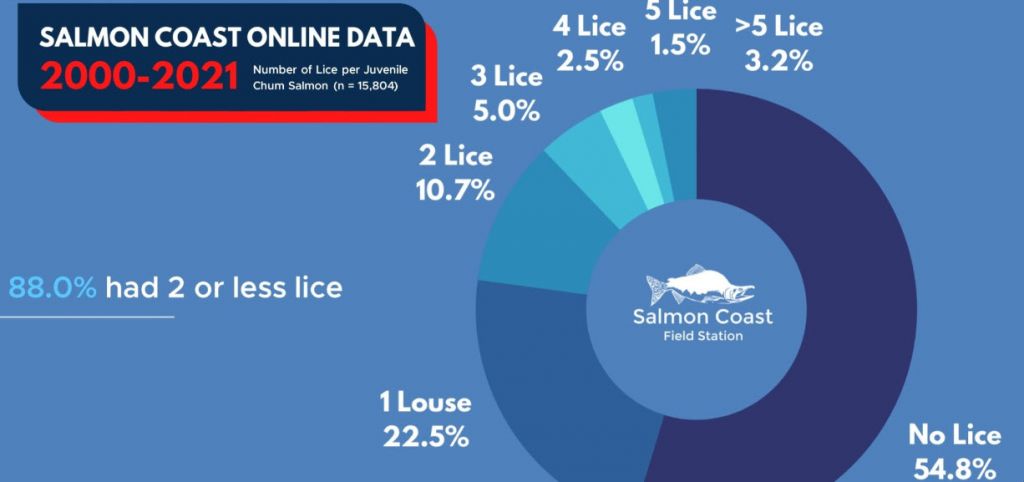Yet more Morton: In reLAKSation no 1978, I analysed the lice data collected by Alexandra Morton’s Salmon Coast Field Station from 2001 onwards. This analysis resulted in the now typical aggregated distribution that I have come to expect from any analyses of host fish and their sea lice burden irrespective of which country from which the data originates.
My graph is repeated here.
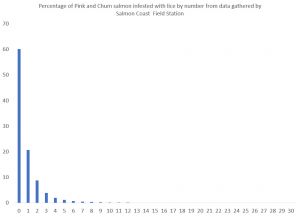
I am regularly accused on social media of being a science denier as well as manipulating the data, let alone being a paid mercenary, although the definition of a mercenary is that they are paid so this is somewhat stating the obvious. However, in my case, I am not paid to do undertake this work. My income is generated through totally different activities. The point here is that the Salmon Coast Field Station data is available to download from their website. I have simply counted the number of fish sampled that are lice free (60% of the sample), the number of host fish with just one louse (20%), the number with 2 lice (10%) and with 3 (less than 5%). Anyone can conduct the same analysis and they should produce the same outcome. There is no manipulation here.
Others have followed my example and analysed the whole data set but for chum salmon only. A member of Mainstream Biological Consulting, a company that samples fish for the sector has taken the Salmon Coast Field Station data and posted the following on social media:
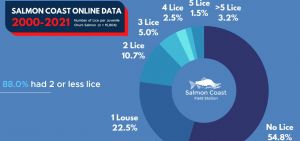
Of the 15,804 fish sampled, 54.8% had no lice, 22.5% had one louse, and 10.7% had 2 lice. The percentage of fish with more than 5 lice was 3.2%. This is not too dissimilar for the spread for all species sampled.
This commentary was prompted by a Twitter exchange between Alexandra Morton and another in which Ms Morton was asked who had posted the above graphic.
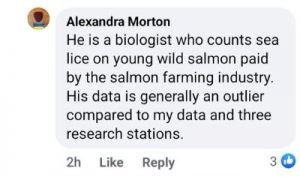
The interesting part of her response is that ‘his data is generally an outlier compared to my data and three research stations.’ I haven’t yet looked at the industry data, but I suspect that irrespective of how much debate there is about actual lice counts, the spread will be very similar to that from the Salmon Coast Field Station data. I really don’t understand her comments about the data being an outlier. The definition of an outlier is ‘a data point on a graph or in a set of results that is very much bigger or smaller than the next nearest data point.’ Or does she mean that his data is just different to hers and that whilst his claims to show that sea lice don’t have much of an impact on wild fish, hers does.
I have broken down the data from the Salmon Coast Field Station into years and the results are shown in the following table:
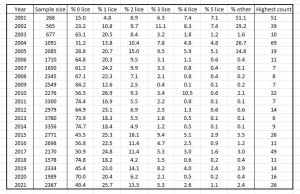
There is some variation from year to year, but this is to be expected as this is a natural response and not one generated in some form of laboratory experiment or mathematically modelled. In 2009, 84.2% of fish sampled had no lice. Five other years had over 70% of the fish sampled with no lice.
In addition to variations in natural conditions such as water flow, salinity and temperature, the size of the sample can greatly impact the outcome. The first two years of sampling resulted in just 268 and 565 fish respectively compared to nearly 4,000 in 2013. The percentage fish with no lice for these low number samples was just 15 and 23%.
Regardless of the specific percentages, the trend for every year is clear, the majority of the fish sampled have no lice or very few. This trend is not unique to British Columbia as similar trends have been identified in Norway, Scotland and Ireland. The meaning is clear too, if the majority of fish sampled have no or very low levels of lice, then they cannot be dying from sea lice infestations as Alexandra Morton contends.
It is also unclear how Alexandra Morton can describe these trends as being the outlier. They are the normal. However, this is not unexpected as anything that doesn’t fit into Ms Morton’s narrative is likely to be considered to be an outlier.
This week Ms Morton posted a statement about her social media profile.
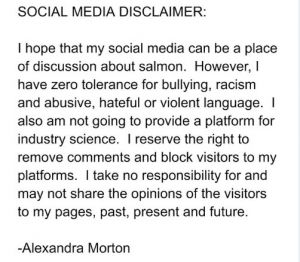
She makes two contrary statements. The first is that she hopes her social media can be a place of discussion about salmon, whilst in the second she says that she is not going to provide a platform for industry science. How she can offer a place of discussion when she is not prepared to consider one side of the debate is more than puzzling. The reality is, like many of critics of the salmon farming sector, Ms Morton does not want to hear the alternative view and the only logical reason why, is that it is likely to undermine her very blinkered narrative.
However, in the case of the sea lice data, this is not industry science but the science of parasite ecology. As I mentioned in my previous commentary about her, I did contact her to suggest she looked at this aspect of the science but I heard nothing back.
Finally, in a more recent posting, Ms Morton wrote that she is sick of the cover-ups and lies around this industry. The damage has been incalculable. In terms of sea lice, the damage is incalculable because it is so small. I would guess that the salmon farm industry is equally sick of the cover-ups (in respect to the extensive misinformation) and lies about the industry.
If I am wrong, I would be more than happy to debate the issues with Ms Morton, or any other salmon farming critic for that matter. I guess I’ll be waiting for a long while yet for any volunteers.
Consultation: The Scottish Government have just announced a consultation on the proposed river gradings for 2023. I am not sure why such a consultation is necessary. Given that last year’s catch was the lowest on record and that all the salmon conservation organisations have expressed concern, surely all rivers should be reclassified as Grade 3 and all the killing of wild migratory fish be banned. I cannot see any other option, yet the proposals aim to encourage wider voluntary catch and release. Why? In the past, there has been a clamp down on commercial netting to the point that it no longer exists. The Scottish Government are to impose a risk based framework on the salmon farming industry even though the area covered accounts for less than 10% of the total Scottish catch and that the regulator, SEPA told the Scottish Parliament, that salmon farming was not responsible for the decline of wild fish and yet the anglers, who in the past have caught and killed around 5.9 million wild fish for sport are still not being subjected to measures that wouldn’t actually stop them carrying out their sport, but would stop them killing any of these valuable fish.
How any of the wild fish conservation organisations can say that they work to conserve wild fish whilst remaining completely silent about killing these fish for sport is a total mystery. Of course, the reason is for them, the only reason for conserving these species is so that they can catch them at the end of a rod and line. It is all about the sport.
I will discuss the proposed river gradings in a future commentary however, there is one that I would like to share here now. From 2019 to 2022 the River Ewe was a grade one conservation river. During the time when the assessments were made 2018-2021, a salmon farm operated in the loch or was in the process of closing down. Last year, was the first year that Loch Ewe was free of salmon farming and yet the river has been downgraded to a grade two. This is clearly nothing to do with salmon farming and I would suggest that as for every other river on the west coast, there are other more important factors at play but what they are remain elusive. This is simply because the wild sector is so certain that salmon farming is to blame all efforts to protect wild fish involve targeting the salmon farming industry. It is only necessary to see that Marine Scotland provide funds to Fisheries Management Scotland for a salmon farm interactions manager but not for any other of the identified pressures. I look forward to hearing why the Ewe System has been downgraded, because for certain it is not due to the presence of a salmon farm.
Grimersta 2: Salmon farming critic, Robert Cameron (if that is his real name) responded on Twitter to a posting about my last commentary. He wrote:
“Grimersta has a huge amount of money going into conservation and restocking. It has 28 major shareholders.
Meanwhile, there is an extinction vortex in rivers where there isn’t money to battle the toxic scourge of salmon farming.”
Andrew Graham Stewart did write in his book that the fishery was subjected to habitat improvement and restocking in the past and he wrote that near enough twenty years ago. I understand that there is no conservation work on the fishery because the habitat is pristine and has never been developed. At the same time, restocking is no longer allowed in Scotland except in extreme circumstances. In the case of Grimersta, the river is productive (which is why it is a Grade One river and also part of the Langavat SAC) so there is no need for restocking.
If conservation and restocking were the solutions for west coast rivers then surely other rivers would have followed suit. It certainly has worked for the River Carron and yet, the wider wild fisheries community do not appear interested in pursuing this approach. They are more interested in planting trees.
The real issue is not how to revive a declining fishery but to examine why the fishery has declined. Mr Cameron and others, including all the wild fish organisations, claim this is because of the impact of salmon farming, but as the catch data from Grimersta clearly shows there is no correlation between the declines of wild fish and the expansion of salmon farming.
Unfortunately, the voices of the wild fish sector appear to have dominated the debate which is why SEPA have been erroneously charged with imposing a totally unnecessary risk assessment framework on the salmon farming industry. Even Marine Scotland Science’s summary of the science doesn’t support the case, which perhaps explains their total reluctance to discuss the science.
Hopefully, one day, Scottish Ministers will recognise that not all the scientific advice they receive can be considered reliable.
Fair game: Although it did not receive mainstream publicity, the Atlantic Salmon Trust (AST) have issued a press release concerning their attendance at the Game Fair. This is described as a Festival of the Countryside but the reality is that it is a show for the hunting, shooting and fishing fraternity. The AST hosted a lunch in conjunction with Fieldsports magazine to connect with their key supporters, ambassadors and donors to share news and their latest research findings to help spread awareness of the plight facing wild Atlantic salmon. I can only wonder whether those attending the Game Fair would be really interested in giving up their sport in order to save wild salmon, or perhaps the AST went with a different message. Given their ambassadors, such as Marina Gibson, are keen anglers, I suspect that abstaining from angling was not the message that AST supporters actually heard.
However, what really attracted my attention in the press release was the message of thanks to the team from Game & Flames who delivered an outstanding lunch featuring sustainably sourced trout from Chalkstream Foods.
Chalkstream trout is of course farmed, and this made me wonder how serving this fish to AST members could be reconciled with the AST’s latest policy statement on Aquaculture (https://atlanticsalmontrust.org/ast-policy-statement-on-aquaculture/).
In fact, the AST’s policy statement on Aquaculture isn’t about a policy statement on Aquaculture at all. It is a policy statement on salmon farming, which is one of many different types of aquaculture. The policy statement has been issued because the AST, in my view, wrongly believe that salmon farming is responsible for damaging wild salmon and sea trout stocks. They say that this is due to a combination of sea lice infestations and interbreeding with farmed salmon and hence they remain strongly opposed to unsustainable open pen aquaculture.
The AST website has a page devoted to salmon aquaculture in which it says that it has updated its positioning statement but when the link is clicked a paper from November 2016 appears. With regard to sea lice, this paper states that based on the current body of research and presentations delivered to NASCO special session on aquaculture (June 2016), AST believes that ICES has provided convincing evidence of direct impacts from open cage salmon aquaculture. I remember this special session well because like most discussions within the wild sector about salmon farming, there was a distinct absence of any balance from the farming sector. Although my own interest in this subject began through my participation in a public debate with Malcolm Windsor from NASCO, the organisation repeatedly refused my offer to speak at that meeting.
Returning to the AST, they continue with reference to Marine Scotland Science’s original Summary of the Science in which the AST reviewed the body of available peer-reviewed published evidence to assess the likely scale of impact of salmon lice. AST stress MSS’s conclusion that this could have an adverse effect on populations of wild salmonids in some circumstances. I can’t remember how many times over the intervening years I have tried to challenge these conclusions, but MSS have always been reluctant to discuss the science. They remain totally unwilling to discuss available peer reviewed papers that would lead to a different conclusion. Surely, it is in the best interests of wild salmon, if every piece of science is considered and not just the selected bits that suit the wild salmon sector.
The AST provide a short bibliography of their science from 2016 and frankly it is poor and given that the AST always stress their reliance on peer-reviewed science, the inclusion of a couple of reports that are not peer-reviewed should be surprising, but it is not. I would have hoped that AST might have updated their website to include their new position statement so I could examine the updated bibliography but perhaps they are too busy with the Game Fair to bother.

